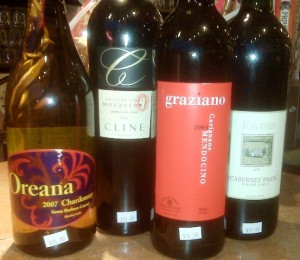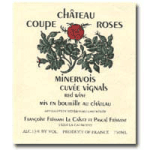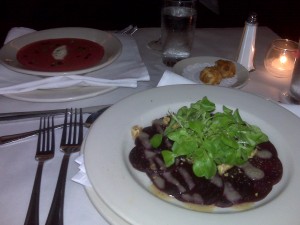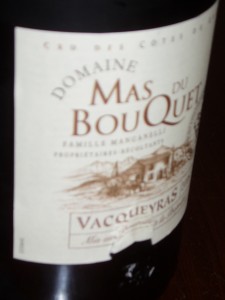 Last Saturday night I visited with friends in Providence as part of a larger weekend of festivities featuring - dum, da, dee, dum! - attending the Newport Folk Festival together on Sunday. Naturally I would bring some wine for dinner. My best friend has an affection for Spanish reds; she and her husband are also fabulously hyper-local, urban farmers, so something from a sustainable or organic producer would be bonus.
While I find it is always good to have some kind of direction, this time I was actually at a loss about what would fit my general criteria. And then, just in the nick of time, last Friday afternoon my colleague and I happened to uncork the Honoro Vera Monastrell to evaluate it. Dan had discovered this new project (made from Organic grapes and hailing from Jumilla, Spain!) from the folks at esteemed producer Juan Gil while I was away at Pinot Camp; it had just arrived on the premises, so he was particularly excited about it - and eager for me to give it a taste. I was excited that he was excited. It doesn't happen like that everyday.
Last Saturday night I visited with friends in Providence as part of a larger weekend of festivities featuring - dum, da, dee, dum! - attending the Newport Folk Festival together on Sunday. Naturally I would bring some wine for dinner. My best friend has an affection for Spanish reds; she and her husband are also fabulously hyper-local, urban farmers, so something from a sustainable or organic producer would be bonus.
While I find it is always good to have some kind of direction, this time I was actually at a loss about what would fit my general criteria. And then, just in the nick of time, last Friday afternoon my colleague and I happened to uncork the Honoro Vera Monastrell to evaluate it. Dan had discovered this new project (made from Organic grapes and hailing from Jumilla, Spain!) from the folks at esteemed producer Juan Gil while I was away at Pinot Camp; it had just arrived on the premises, so he was particularly excited about it - and eager for me to give it a taste. I was excited that he was excited. It doesn't happen like that everyday.
Made from 100% Monastrell grapes, the wine was opulent with succulent black plum, boysenberry and bramble fruit. It stopped me in my tracks. It was as juicy as it was accented with turned black soil, mushroomy earth and spice. Its silky smooth texture (my ultimate vinous pleasure) prompted an immediate high-five to Dan for "finding" it.
Over the weekend my friends were also "Wow'd". (Gotta love when you hit the nail on the head.)
Then, the next day while we were at the Festival grooving to the sound of Brown Bird, my work caught up with me in the best possible way: I nudged my BFF, smiled and said I know I'm a wine nerd, but these guys sound like last night's wine - his voice is rich, seductively smooth and thrilling; hers is the gorgeous, clean-cut note of acidity that brings it on home.
Heads bobbing, we wished we had another glass in hand.
Pairing: Garliky chopped sauteed kale and green beans; Grill-charred Salmon (with grilled sausage accompaniment optional)


 At
At 
 Jaume used his pepito (plastic theif) to “steal” a bit of wine from each of the 2010 barrels enjoying their siesta (pre-aging/bottling) in barrels below the alfresco tasting porch so I could taste them each au natural. What an experience! This is the sort of opportunity that drives home the essence of varietal expression. Grenache is uniquely Grenache, with natural variation depending on the vineyard site; but at the end of the day, a Granny Smith apple is too tart to be called Macintosh just like Grenache is too red-berry fruited to be called Mouvedre, a more smoked meat, gamey, blueberry/redberry fruit flavored varietal. How varietals work together is what makes a particular Clos stand out in their efforts (aka when to pick, in what vessel one should ferment each varietal, and later, what balance of grapes will comprise the final wine).
Jaume used his pepito (plastic theif) to “steal” a bit of wine from each of the 2010 barrels enjoying their siesta (pre-aging/bottling) in barrels below the alfresco tasting porch so I could taste them each au natural. What an experience! This is the sort of opportunity that drives home the essence of varietal expression. Grenache is uniquely Grenache, with natural variation depending on the vineyard site; but at the end of the day, a Granny Smith apple is too tart to be called Macintosh just like Grenache is too red-berry fruited to be called Mouvedre, a more smoked meat, gamey, blueberry/redberry fruit flavored varietal. How varietals work together is what makes a particular Clos stand out in their efforts (aka when to pick, in what vessel one should ferment each varietal, and later, what balance of grapes will comprise the final wine).

 I was channeling Disney and Belle a couple of weeks ago. Today I envision a Greek god named Minervois. Except the name "Minervois", a small sub-region of the Languedoc in France, actually comes from the village of Minerve. Who knew? Because when I re-tasted an old favorite from this area, I wasn't just pleased with the result, it was a near-spiritual experience - for just $13 (retail).
Backing up a touch, Minervois offers the world reasonably priced reds typically comprised of Grenache, Syrah and Mouvedre, perhaps with some Carignan or Cinsault mixed in for good measure. It depends. It's an experimental part of the world down there. Some wines are purely easy quaffing selections. But others are quite memorable. Typically the latter come from low-yield vines (remember, this means concentrated fruit flavors) in the rocky hills above the plateau.
I was channeling Disney and Belle a couple of weeks ago. Today I envision a Greek god named Minervois. Except the name "Minervois", a small sub-region of the Languedoc in France, actually comes from the village of Minerve. Who knew? Because when I re-tasted an old favorite from this area, I wasn't just pleased with the result, it was a near-spiritual experience - for just $13 (retail).
Backing up a touch, Minervois offers the world reasonably priced reds typically comprised of Grenache, Syrah and Mouvedre, perhaps with some Carignan or Cinsault mixed in for good measure. It depends. It's an experimental part of the world down there. Some wines are purely easy quaffing selections. But others are quite memorable. Typically the latter come from low-yield vines (remember, this means concentrated fruit flavors) in the rocky hills above the plateau. Imagine my delight when I popped over to
Imagine my delight when I popped over to  We've had a lovely bender of 80 degree temps here in Beantown. Love it. My soul is being nourished with Vitamin D, my grill is getting some much needed TLC, and I have an "excuse" to drink red wines even when it is warm out.
This week I brought home a bottle of one of my all time favorite wines:
We've had a lovely bender of 80 degree temps here in Beantown. Love it. My soul is being nourished with Vitamin D, my grill is getting some much needed TLC, and I have an "excuse" to drink red wines even when it is warm out.
This week I brought home a bottle of one of my all time favorite wines: